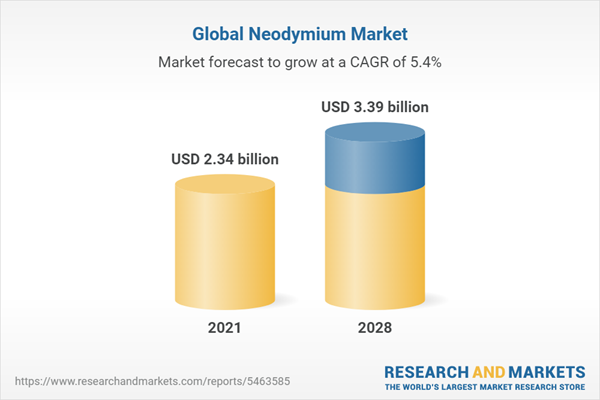
The global neodymium market size is expected to reach USD 3.39 billion by 2028. It is expected to expand at a CAGR of 5.3% from 2021 to 2028. The demand for electrical and electronic products is projected to assist the market growth over the long term.
Neodymium-based magnets are used in a variety of consumer and automotive electronic products. The products such as air conditioning inverters, washing machines and dryers, refrigerators, laptops, computers, and various loudspeakers require permanent magnets for their functioning. The emerging middle-class population is likely to drive the demand for these products, thus benefiting the growth of the market.
The healthcare sector is projected to offer new sales streams for the market vendors. MRI scanners and other medical equipment require neodymium materials for their implementation. This demand is likely to be led by Asia Pacific countries, such as China. Europe is projected to witness a decline in the share for the use of neodymium in the healthcare sector over the coming years.
The wind energy end-use segment is anticipated to register the fastest CAGR of 5.6% in terms of revenue from 2021 to 2028. Government and private investments to boost the renewable energy capacity installation are likely to remain a key growth factor for the segment. For instance, foreign direct investment for renewable energy in India has increased from USD 1.2 billion in 2017-18 to USD 1.44 billion in 2018-19.
Numerous companies and researchers are actively working on the development of recycling technologies for neodymium. Current costs are high and the infrastructure for the recycling of this critical material is under developing stages. Most of the rare earth elements including neodymium go to waste in dust and ferrous fractions. Since rare earth elements make up only a small percentage of the material in electronic waste, researchers need to look for economies of scale if recycling has to be done.
Neodymium Market Report Highlights
- By application, the magnets segment held the largest volume share of over 65.0% in 2020. The demand for the segment is likely to be led by the automotive, wind energy, and electronics end-use industries
- In terms of end use, the automotive segment dominated the market with a revenue share of over 55.0% in 2020. The demand for permanent magnets in conventional and electric vehicles is contributing to the growth of the market. The increasing penetration of electric vehicles is projected to remain a key driver for the segment
- The wind energy end-use segment is anticipated to witness the fastest growth over the forecast period. Global focus towards renewable energies is projected to promote the expansion of the wind energy segment
- Asia Pacific held the largest revenue share in 2020 and is expected to witness the fastest growth over the forecast period. Increasing production of permanent magnets, coupled with the growing end-use industries in China, Japan, and India, is projected to assist the regional market growth over the forecast period



